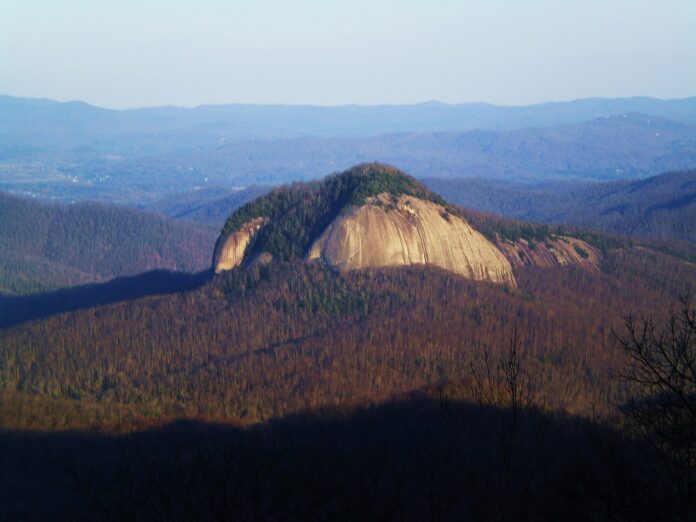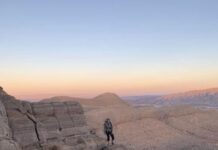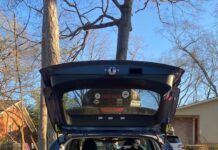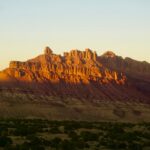Looking Glass Rock is one of North Carolina’s most prominent rock features. This lump of whitesand granite is what geologists refer to as a “pluton,” or a big piece of rock that could’ve been a volcano. But it was so impatient that by the time it reached the surface of the Earth it had already cooled. This almost-volcano was big and substantial enough to make it to the surface to form a 3969-foot upside down bowl of granite. That might seem like chump change elevation to those of you who live out West. But here, in North Carolina, that’s about 2,000 feet higher than the nearby town of Brevard.
This pluton is home to some of North Carolina’s most notorious rock climbs. Most people would agree that Looking Glass has it all. You can find climbs that are “well protected,” which means that if you bring the right climbing gear, the risk of death is relatively small. But the headstrong and bravest climbers can also find themselves cheating death by clinging to difficult, and run-out routes (where gear placement is commonly unavailable, making the risk of death much higher).
The First Looking Glass Pilgrims
You have to wonder what kind of a crazy son of a bitch Looking Glass Rock’s first climber was. Who saw this hunk of granite off in the distance and said, “I need to bushwhack through brambles and bushes for several miles so I can make it to the top of that feature”? Like me, someone else must’ve been interested in getting a little bit uncomfortable.
It turns out that Steve Longenecker, Robert John Gillespie, and Bob Watts were those crazy sons of bitches that climbed Looking Glass Rock to the top for the first time in 1966. With the help of pitons, and make-shift harnesses, they spent two years scouring the wall for climbing routes. Eventually they discovered a line that would become, “The Nose,” and all three of those pilgrims climbed to the top of Looking Glass Rock for the first time.
Today, climbers wear carefully molded shoes with an edge and an aggressively pointed toe in order to improve their odds of getting to the top of a route, making what was once impossible become plausible. But in 1966, Longenecker, and Watts wore boots and motorcycle helmets to the top of the Nose, making their accomplishment even more mind-boggling.
Most climbers imagine Yosemite’s “Nose” when they hear about a route of that name. Alex Honnold and Tommy Caldwell speed climbed The Nose, making their way up a 3,000-foot wall that takes normal climbers multiple days to complete, putting the route into the spotlight. Looking Glass Rock’s Nose is about a fifth of the height of Yosemite’s feature.The grade is a moderate 5.8, and it takes you through a series of eyebrows, a small ramp, and a crack. Most people climb it in four pitches (or four rope lengths if you bring the right rope). When you’re in a good rhythm, it’s possible to climb the route in about two hours. And the route attracts a lot of new traditional climbers.
My Own Pilgrimage on Looking Glass
When I arrived in North Carolina in 2020, I was green-eyed and eager to explore. I’d already heard about Looking Glass Rock. Its reputation preceded itself. I knew I needed to climb it, even though I wasn’t much of a climber. My self-written Outside Magazine biography described me as a “wannabe climber,” attesting to how little I knew about the mechanics of everything. But I knew I wanted to see the world from the top of that stunning pluton. And it didn’t take long for me to find a local climber who was willing to take me there.
Tommy spent the first half of his life exploring Yosemite Valley, where American climbing was born. He possessed the rock addiction that caused him to spend every waking moment consumed by climbing moves and routes. And then he’d work out the moves in his mind when he became unconscious, too.
When he asked me to meet him at 6:00 am in the nearby parking lot on a winter day, I knew that the effort would be worth the reward. I set out from my house before the sun peeked over the mountains wearing two jackets, a beanie, multiple pairs of pants, and a smile. I loved that shit. No one could deter me from putting myself through pointless pain to climb a multi-pitch route in January — especially one on Looking Glass.
Tommy was undeterred by the cold. He’d seen Denali in its majesty, Mount Shasta, and plenty of other snow-capped peaks. North Carolina’s mild winter wasn’t enough to stop him from climbing. And, I didn’t know if it was the desire to explore North Carolina or the urge to learn how to climb that led me here, but it seemed that I was doing both on this particular morning.

Climbing “The Nose”
The rock was cold to the touch under the early-morning shade when Tommy began his ascent. His movements were fluid and connected. Confident in his ability to make it to the top, he placed a minimal amount of gear (safety pieces) while he moved his body upwards. First, he came to the eyebrows — the little concave features with small ridges that look like little human expressions embedded in the rock. Every motion was graceful, delivered with the kind of precision only seen from those who practice over and over and over.
Finding new climbing partners can be an intimidating task because many climbers’ egos are bigger than their abilities. If you end up following someone who doesn’t know as much as they say they do, a casual day outside can turn into a life or death situation. While searching for the right partner, I found someone who was known in the community for dropping people on toprope. Someone else taught me to back clip while we were in the gym. For the most part, instincts and logic kept me alive. But I wanted to thrive.
You could almost see the wheels turning in Tommy’s mind when you climbed with him. It was like he was evaluating 100 moving parts all at once. He wasn’t just making sure that his choices were safe, he was double checking your knot, making sure your head was on straight, and feeling out the dynamic before he ever left the ground. By the time he reached the end of pitch one, I knew I was in good hands.
My Turn to Climb
He smiled at me patiently while I overgripped the eyebrow features and began to follow his movements. But instead of moving with grace like he’d just done, I threw myself at the wall, hoping that a lifeline would appear in front of me. I knew that the gear I was using was designed for this — that my harness was extremely unlikely to break, and the cams that he used to fasten us to the walls would only expand as we pulled on them. But human instinct made me uncomfortable.
Each movement took me higher, widening my fears while I created more distance between myself and the ground. The rubber on my shoes gripped the wall, keeping me plastered to the surface. But then something within me released. My movements became intentional. I stopped kicking the walls and began placing my toes on tiny edges. I softened the muscles in my arms, realizing that I’d stay attached to the wall even if I tried a little less. And the noise in my mind evaporated by the time I reached the safety of the hangers. I’d managed to move through my own terror, pushing forward with sheer will power even when my knees buckled.
Climbing Pitch Two
Pitch two came with less tension. Tommy scaled the ramp, leaning into the strength of his shoulders to propel him upwards. I mimicked his movements, hoping to stay fixed to the wall. And it wasn’t long before we’d made it to the top of the second pitch.

One of the reasons that we climb becomes evident when you clip into the anchor and look behind you. The horizon stretches in every direction, and it’s easy to see how far you’ve come.

Although it’s not always obvious, it’s navigating your fears, your worries, and your anxieties that leads you to this point. Getting the chance to look back transforms your relationship with who you are.
On this particular morning, I wasn’t sure where I was headed. I wasn’t sure why I was heading in any particular direction at all. But the bottomless chasm below my feet validated my belief that anything was possible, and that it took a lot to get to where I was.
For More Inspiration:















